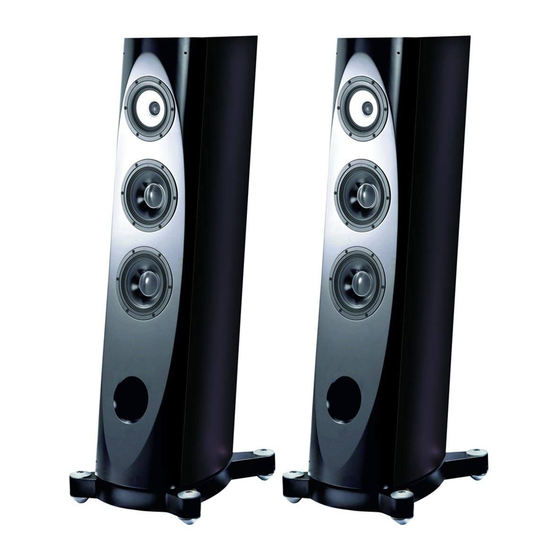Pioneer S-1EX Instrukcja obsługi - Strona 4
Przeglądaj online lub pobierz pdf Instrukcja obsługi dla System głośników Pioneer S-1EX. Pioneer S-1EX 28 stron. Ex series
Również dla Pioneer S-1EX: Broszura i specyfikacje (16 strony), Instrukcja serwisowa (12 strony)

Connecting to an amplifier
Before connecting to your amplifier, make sure that the amp is
switched off.
This speaker does not include speaker cables used for
connecting to a stereo. Note the following when selecting
speaker cables.
• Use heavy-gauge speaker cable if possible, and keep the
cables to the minimum necessary length.
• If the length of cable required for left and right speakers
differs, use cables of the same length, matched to the
longer distance.
• Cables have differing characteristics. Keep this in mind
when using any cable.
• Select cables with as little resistance as possible, and
make sure the cables to the speaker terminals and amp
are firm and secure.
CAUTION
These speaker terminals carry HAZARDOUS LIVE
voltage. To prevent the risk of electric shock when
connecting or disconnecting the speaker cables,
disconnect the power cord before touching any
uninsulated parts.
Connecting the cables
1
Switch off the power to your amplifier.
2
Connect the speaker cables to the input terminals
(lower) on the back of the speaker. For input terminal
polarity, red is positive (+) and black is negative (–).
Grasp the cap knobs on the lower input terminals and rotate
them to the left (counter-clockwise), insert the speaker cable
wires into the holes in the terminal posts, then tighten the
knobs to secure the short bar as well as the wires.
• You can also use banana plugs for this connection. To do
so, you must first remove the caps from the terminal
posts.
Short bar connectors
Black terminal ( )
3
Connect the other ends of the cables to the amp's
speaker output terminals (for more details, refer to your
amp owner's manual).
4
En
• After connecting the plugs, pull lightly on the cables to
• If the cables' wires happen to be pushed out of the
• When using a set of speakers connected to an amplifier,
Bi-wiring Connections
Bi-wiring requires two cables for each speaker, one for high
frequencies and one for low frequencies. Using separate
cables for the high end and low end improves the sound.
D3-4-2-2-3_A_En
Black Red
1
remove the two short bars.
In this state, the low-frequency speakers and the higher-
frequency speakers are completely independent. Store the
short bars in a safe place for later use. The lower terminals
are for the bass, and the upper terminals are for midrange
and treble sounds.
2
holes, then tighten the knobs.
Red terminal ( )
Caution: when bi-wiring
Note that in this setup, connecting the cables with the
polarity reversed may seriously degrade the tone; refer to the
section "Connecting the cables" again and confirm that the
cables are connected properly.
make sure that the ends of the cables are securely
connected to the terminals. Poor connections can
create noise and interruptions in the sound.
terminals, allowing the wires to come into contact with
each other, it places an excessive additional load on the
amp. This may cause the amp to stop functioning, and
may even damage the amp.
you won't be able to obtain the normal stereo effect if the
polarity ( , ) of one of the speakers (left or right) is
reversed.
Speaker
Amplifier
R ch L ch
Loosen the cap knobs on the left input terminals and
Insert a speaker cable into each of the terminal post
High frequency
terminals
Low frequency
terminals
Black terminal ( )
Speaker
Black Red
Red terminal ( )
